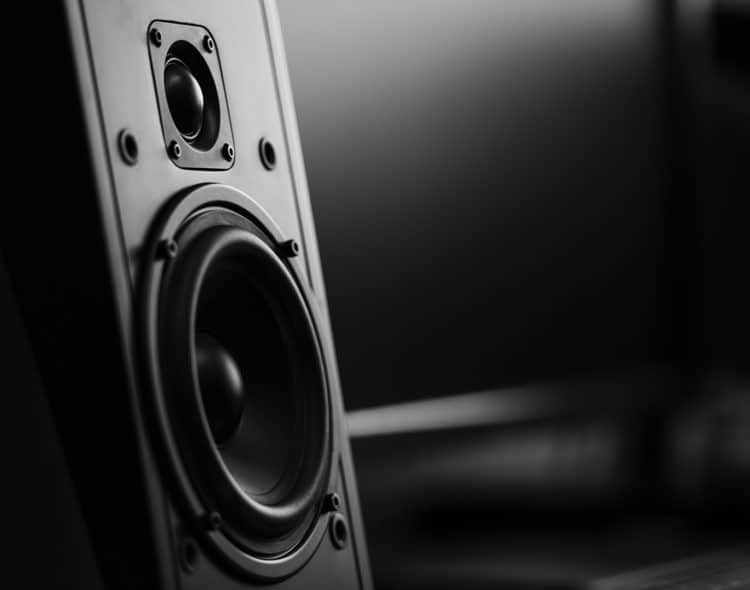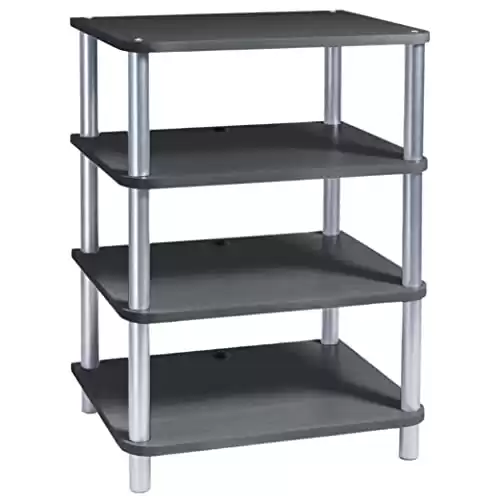Think about the last time you went to a concert or a show that stood out.
For me, I went to see a band called Plankeye back in my early adult years. That group could grind out a sound that was a mix of Seattle grunge and heavy metal that just felt right whenever I heard it.
I can remember being in the third row back of this concert, right next to this stack of speakers. One of them was pointed toward the band.
“Why are they doing that?” I asked my buddy at the time.
He shrugged back. “You’ve got to hear the music you’re playing,” he said. That’s when I realized the top speaker was really a massive amplifier.
There were three of them pointed at the stage, with three more sitting on the floor in front of the musicians.
Can You Put an Amplifier on Top of a Speaker?
Placing an amplifier on top of a speaker is a different experience than setting electronics on a subwoofer. Although there is the potential for vibrational fatigue, stacking amps is a common practice to save space or project sound. The primary consideration is the weight tolerance of the cabinet.
It doesn’t matter where you or your band performs. You want the music to sound awesome for your audience!
Whether standing next to the stage or all the way in the back, the experience should be similar.
You want high-quality tones so fans can jam with you, sing along, or relax in the sonic bliss produced.
A key element of making that outcome happen involves speaker and amplifier placement.
When electronics get too close to each other, they can squeal or create feedback that no one wants to hear full-time.
Although placement is important, the angles used for your amp can also decide whether the performance is great or lousy in the ears of the crowd.
My first introduction to electronic feedback came when I was 13. There was this girl I was crushing on, and we were doing a puppet show tour with a youth group. It was this mentorship, teach kids about honesty type of thing.
I got it into my head that we’d have to sit together if our microphones were closer to each other.
As I’m prepping the area behind the curtain for the puppets, I slowly move the mics closer to a point where I think she’ll be comfortable.
After finishing the prep work for the show (while other elements of our production are happening), I think to myself, “I bet she’d sit closer to me if the microphones were right next to each other.”
So, that’s what I did. And that’s also how I learned my lesson about electronics placement. The feedback was so loud that it affected the hearing in my right ear permanently.
Why Amplifier Stage Location Is Critical
The thing about an amp is that it’s a powerful addition to your lineup, even if you’re using one at a lower wattage. Hurting your ears is not good, even if it gets you sympathy from your crush for the rest of your production trip.
It’s tempting to think that stacking amps on top of speakers right at the audience is a great setup, but it is usually detrimental to the listening experience.
Although you don’t want to hide your amplifiers because you want to hear the audio, you can’t create total exposure.
There’s an old Sunday school song called “This Little Light of Mine.” One of the verses says, “Hide it under a bushel? No! I’m gonna let it shine!”
That’s the approach to take when stacking amps on speakers. Don’t hide it. Place the amplifier in a spot where the sound can “shine” for everyone.
When you can find a balanced spot, people will gravitate toward the best places to hear what you’re playing or producing.
The best placement option is to have the amplifier not directly face the audience, but be slightly off-center, angled toward the singer (if you have one).
When the speakers are elevated, the energy goes above the head of the performers or the audience.
It can ricochet off some surfaces and get absorbed by others while still offering an authentic sound.
You can get a lot of low-end noise when your audio bounces off the floor. Stacking removing it.
The one step you’ll want to remember here is that you can’t point the amp close to the microphones of others.
Although you shouldn’t get feedback, the mic can pick up the audio and broadcast it through the sound system, muddying the eventual result produced.
The Humming Problem When Stacking Amps and Speakers
There are several amps and speakers you love for different reasons, so you decide to put them together.
Perhaps you have two amplifiers in your setup because one hits the crunchy sounds you love while the other delivers an incredible overdrive.
If you’re like me, the first thought that goes through your head is something like, “I’ll just use them together.”
If you go out of the left and right outputs from a pedal, plug one into each amp, the best of both worlds occurs… right?
Not necessarily.
When you want to use two amps simultaneously or stack amplifiers and speakers, you’ll need to know a few things before flipping on the power.
- When plugging into dual amps, a strong humming sound often occurs. It’s loud enough that your speakers can vibrate. This issue comes from the ground, and you can’t just turn your three-prong plug into a two-prong alternative. Improper grounding can cause severe injuries.
- You can use a dual-mono box to create a slight delay so that when the signal gets received simultaneously, you’ll get a more powerful sound.
- There is the option of sending your signal from two different amps into a sound station, audio controller, or another tool that allows you to tweak the configuration.
In most circumstances, you can stack an amp on a speaker without much trouble if you have high-quality cables and a reasonable cabinet that can deaden the vibrations that each unit causes.
When you can find a combination that serves your needs well, the final issue to resolve involves the response.
Each speaker and amp, including the same make and model, responds differently because of its build.
You’ll need to adapt to your setup for the sound to make sense to you and your audience.
How Should I Stack My Amplifiers on Speakers?
Amplifiers are usually the heaviest item in your audio setup. That means one can place considerable weight on the bottom speaker if multiple items are included in the tower. Manufacturers recommend to have an amp sit on a single speaker to avoid potential complications.
If you have enough space, the best performance you’ll receive occurs when the equipment is kept apart from each other.
Having a separate rack encourages a bit more from each item while removing stacking height restriction concerns.
When you have an equipment rack with your setup, it allows each item to be isolated from all the others, which is often beneficial for the eventual sound.
With everything placed on a shelf, you won’t have any interference that could impact the performance of sensitive equipment.
In the early days of my music and taking gigs with different bands, I had to haul my own equipment in the back of my 1979 Mercury Capri.
It wasn’t practical to have an elaborate setup, so I used a sound-isolating furniture stand to create my stage presence.
I could load my amp and speakers in the back (it was a hatchback model) while having the “rack” disassembled in the passenger seat.
When I’d get to the venue, I could assemble the piece, unload the speakers, and be ready to go in about half an hour.
Today, I’ve found a similar experience with the Sanus Systems AFA Stand. AFA stands for “Accurate Furniture Audio.” Although it isn’t portable, I love how the powder-coated steel pillars and lacquered shelves create a stylish setup for speakers and amps.
The shelving unit is capable of holding up to 325 pounds. We have three of these at home: one for console gaming, another for music, and the third for displaying awards.
Since it offers open architecture, you have plenty of airflow to support your AV equipment without worrying about overheating.
A built-in cable management system ensures that you can maintain a clean look, while the adjustable feet ensure that stability occurs even when the floor is a little uneven.
When you’re ready to play, your sound system must deliver a result that lets your creative light shine.
Stacking amps and speakers, especially when they’re on a rack or shelving unit, helps that result occur.



